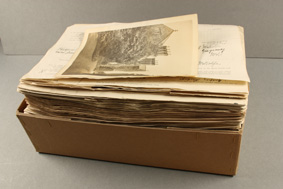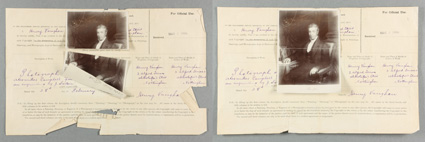As a conservator, my favourite archival material has always been photographs. There’s just something magical about photography’s mixture of chemistry and artistry that particularly captures my imagination. Therefore, I’d like to share one of the photographic projects we’re tackling in the Collection Care studio.
Recently, as one of our large, ongoing projects, we’ve been conserving and re-housing part of the COPY series. The COPY series comes from the Copyright Office at Stationer’s Hall and contains the forms of application for registration of proprietorship from 1837-1912 of different artistic, commercial or literary categories, one of which is photographs. Attached to most of the forms submitted are one or more photographic prints, providing a representation of what was being registered.

Example box from COPY 1 series before re-housing
So here’s our challenge: We have 250 boxes each containing up to 600 forms and there is both physical and chemical deterioration to the forms and photographs.
The forms are housed in over-stuffed boxes, large photographs are folded to fit in the standard size boxes and handling has meant that the photograph was often bent to read the text on the form. The chemical damage includes colour change to the photographs or the forms due to adhesives used to secure the photographs to the forms, or due to transfer of the image of a photograph on to a paper form it has been in contact with.

Left to right: Detail of adhesive damage on a form, colour change visible on the edge of a photograph where it is adhered to a form, multiple images adhered to the same form
And our solution: Where deemed necessary for the chemical or physical stability of the materials we are separating the photograph and form with the use of controlled moisture and doing minimal repair work to stabilise both materials. The photos and forms are then encapsulated in clear plastic (polyester) sleeves which are sealed. This enables both pieces to be easily viewed and provides protection for the photographic material which can otherwise be easily damaged when handled with bare hands due to the acids in the skin reacting with surface of the photograph.
Finally, the forms and photographs are placed in archival quality folders, and only the contents of approximately 125 forms per standard size box. Those oversized photographs in the series that were formerly folded have been flattened before being encapsulated in clear polyester and stored in special oversized folders.
This is a really fascinating collection, one that absorbs you, and you can spend a great deal of time just flipping through the photographs. Now the collection will be housed in a way that both facilitates this and protects it for future generations to enjoy.

This is a fabulous collection which I have used so a great bit thanks for the project – does mean that parts of it won’t always be available but it’s worth the wait – are volunteers indexing it also? was that a rumour I heard?
Hi Kath,
Thanks very much for commenting, it is wonderful to hear from someone who uses the collection and that the work we do is appriciated!
When we started this project, we did have some volunteers helping us out as part of the re-housing project, but as far as I know there is no volunteer project around indexing this series.
Kath,
You are right there was a volunteer project working on indexing photographs registered for copyright between 1883-1912.
The Friends of The National Archives entered information gleaned from the COPY 3 registers on to Excel spreadsheets. Advice & Records Knowledge staff are currently in the process of editing this data adding the additional information contained on the COPY 1 entry forms with the annexed photographs. As this work is completed the information is added to Discovery. About 130 COPY 1 pieces for this period are now searchable by key word online. We still have 79 pieces that we are currently editing.
Hi:)
PHOTOGRAPHING PHOTOS
Been going to Kew since 1996 – since 2004 have used a digital camera to photograph old police photos but on Tuesday (July 9th, 2013) was told I can’t slide the photos out of the clear covers (if they are in them) even though I thought that was what the white gloves were for – I wasn’t actually touching the photo once it was out of the cover. The reason for this u can’t photograph through the clear folder – due to the reflexion and glare (those very bright lights in the reading room) [The camera stands facing the help desk are the best of a bad job as those lights don’t hit there so badly]
It seems ok to photograph photos when they are not in these folders (subject to the white gloves, of course). Has anyone any ideas how to photograph through the clear covers, or has Kew thought about this?
Yours
Matthew Spicer
SL4
Hi Matthew,
Thanks for getting in touch. We ask that the photographs are not removed from the clear polyester envelopes to reduce the risk of their loss and disassociation and also to reduce the chance that the photograph surface might be damaged by removal or re-insertion into the clear polyester. In fact, the photographs being enclosed as part of the above project are sealed inside their envelopes. White gloves are provided for handling photos that are not in the clear polyester enclosures.
The choice of clear polyester to encapsulate photographs is made with the preservation of the photograph in mind. There is currently no other material available that is conservation grade and allows the photograph to be viewed without handling. If you are unable to obtain a satisfactory image under reading room conditions you could consider using our record copying service.
Hi Sarah:)
Thanks for reply:
Yes next time at Kew I will ask about the record copying service.
Just for your information – the old police photos this is about have never been in SEALED clear covers – these, to me, look like covers that the photos were put in at the time, when the files was sent to u – indeed they mostly cover CRIM1 the Old Bailey – it is not until cases from the mid-1960s that non Old Bailey cases – the ASSI series – that any of the photos appear in covers, so I don’t think these are Kew covers as such ??
ATB
Matthew:)
Hi Matthew,
You are likely correct that this was how they were transferred to us. I’m not familiar with the series’ you mention myself, but given the dates you are talking about they would have been transferred relatively recently. The Collection Care department helps put together guidance for government departments that are preparing records for transfer and we do request that they put photographic material in clear polyester envelopes. These are typically not sealed on all four sides as you need specialist equipment to seal the photograph inside the polyester and for some photographic material types sealing is not a good idea – and identifying those particular photographic processes is difficult and requires specialist knowledge. So government departments use standard size polyester envelopes typically sealed on two sides.
So while they might not have been put in the envelopes by those of us working at Kew, it was likely done following our more recent preparation guidance.
I hope this makes some of our thinking around polyester enclosures for photographs clearer. Thanks for taking the time to ask some questions on the blog!
Hi Sarah:)
The two main series with old police photos were CRIM 1 for the Old Bailey/CCC – i.e. London; and the rest of England & Wales is ASSI. These files are/were normally opened after 30 years, so the material that I am primarily interested in and sometimes are in clear covers (I don’t think I have ever come across one actually sealed – ‘sealed’ by virtue of a tag yes, so u couldn’t slide it ouf the cover) would have been available at Kew from the 1980’s- mid 1990’s. And basically outside Metropolitan Police area they were using photo-albums until early/mid 1960s, and so these are/were ‘covered’/protected like a normal album, i.e. not plastic covers
Have u thought of u yourself digitially photogrpahing the pictures so that the photos could be viewed that way ??
Matthew:)
SL4
Hi Matthew,
Sorry for the delay in getting back to you. There is quite a process behind the decision to digitise parts of the collection here at TNA and as this isn’t my specialty I went to a colleague, Gary Thorpe, with your question – here is his response:
“At present we have no plans to digitise the CRIM 1 or ASSI series and make them available online, but they are certainly worthy of further investigation.
We hold an in-house bi-monthly Forum where digitisation proposals are discussed and the appropriate resource can be allocated to digitise, whether that is in-house resource of from one of our commercial or academic partners.
I am sorry that I am unable at this stage to say exactly if these series will be available online but I wish to assure you that we do treat all such enquiries seriously whether they be from staff or members of the public. If and when we have firm details of any digitisation project concerning the CRIM 1 or ASSI series, we will publicise them.
Incidentally, you may be interested to know that photographs of the habitual drunkards in MEPO 6 were digitised and published online earlier this year by our partner findmypast.co.uk as part of their Crime, Prisons and Punishment collection which is due to be released in full later this year. The habitual drunkards records specifically relate to pieces 77-88 within this series and are the portraits and descriptions circulated to licensed persons and secretaries of clubs and cover the years 1903 to 1914 – a little earlier perhaps than you were looking at in CRIM 1. Nevertheless they are searchable and viewable via this webpage at Findmypast – http://www.findmypast.co.uk/search/crime-prison-punishment/. Whilst these records are free to search there is a charge to download full transcriptions and images of the records from this partner website but these records can be accessed in our Reading Rooms on site at Kew where the charges have been waived.”
I would like to add that the idea of digitisation of photographs is not one that is workable. One of the ASSI files I saw last week contained a warning that they contained ‘distressing photographs’ but were in clear pockets and I think that that is wrong not only for the person looking at the file to have to look at these photos and so I stopped before the clear pockets but also for any people who share the same desk. Surely this policy of clear pockets can’t be right?.
Hi David:)
…. but isn’t that a decision of the government/law who decided to release material – some of the files are marked 50, 75, and 100 years so someone has made that decision that it is ok to view them with that warning – i have been looking at police photos at kew since 1996 and no-one has ever complained who was sitting next to me – i doubt very much they even noticed it – …. also some photos were put by the police in old traditional photo-albums folders.
also that would be an argument for digitisation – then the photos would only be available on-line (and if u wanted to copy them u would have to pay for them and u would then have a record of who had copied them) over the years police photos have been used in books, on tv etc ??
Matthew:)
Hi Sarah:)
Thank u very much for giving my message to Gary Thorpe and thank him for his response – it is certainly and interesting subject
Yours,
Matthew:)
SL4